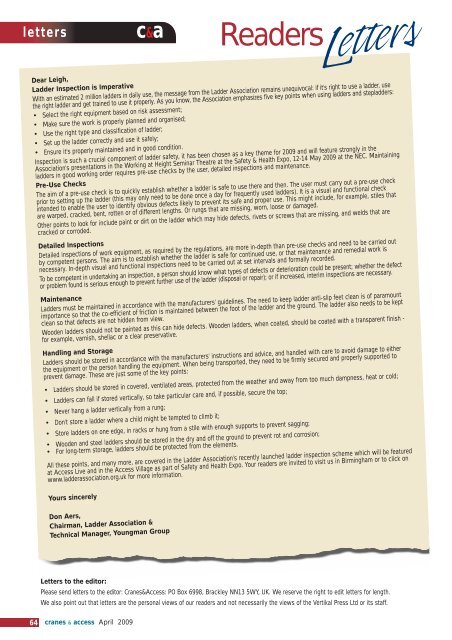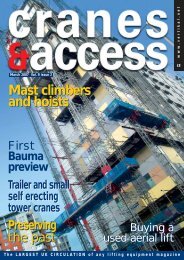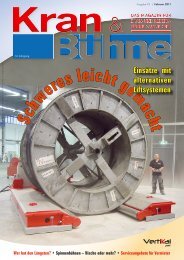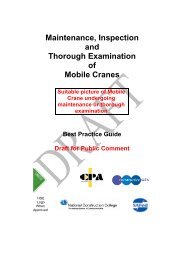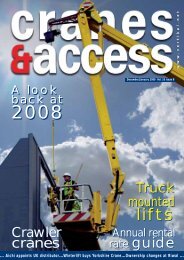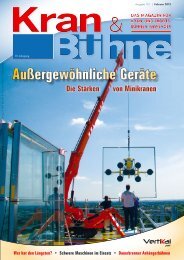You also want an ePaper? Increase the reach of your titles
YUMPU automatically turns print PDFs into web optimized ePapers that Google loves.
letters c&a Readers etters<br />
64 cranes & access April 2009<br />
L<br />
Dear Leigh,<br />
Ladder Inspection is Imperative<br />
With an estimated 2 million ladders in daily use, the message from the Ladder Association remains unequivocal: if it's right to use a ladder, use<br />
the right ladder and get trained to use it properly. As you know, the Association emphasizes five key points when using ladders and stepladders:<br />
• Select the right equipment based on risk assessment;<br />
• Make sure the work is properly planned and organised;<br />
• Use the right type and classification of ladder;<br />
• Set up the ladder correctly and use it safely;<br />
• Ensure it's properly maintained and in good condition.<br />
Inspection is such a crucial component of ladder safety, it has been chosen as a key theme for 2009 and will feature strongly in the<br />
Association's presentations in the Working at Height Seminar Theatre at the Safety & Health Expo, 12-14 May 2009 at the NEC. Maintaining<br />
ladders in good working order requires pre-use checks by the user, detailed inspections and maintenance.<br />
Pre-Use Checks<br />
The aim of a pre-use check is to quickly establish whether a ladder is safe to use there and then. The user must carry out a pre-use check<br />
prior to setting up the ladder (this may only need to be done once a day for frequently used ladders). It is a visual and functional check<br />
intended to enable the user to identify obvious defects likely to prevent its safe and proper use. This might include, for example, stiles that<br />
are warped, cracked, bent, rotten or of different lengths. Or rungs that are missing, worn, loose or damaged.<br />
Other points to look for include paint or dirt on the ladder which may hide defects, rivets or screws that are missing, and welds that are<br />
cracked or corroded.<br />
Detailed Inspections<br />
Detailed inspections of work equipment, as required by the regulations, are more in-depth than pre-use checks and need to be carried out<br />
by competent persons. The aim is to establish whether the ladder is safe for continued use, or that maintenance and remedial work is<br />
necessary. In-depth visual and functional inspections need to be carried out at set intervals and formally recorded.<br />
To be competent in undertaking an inspection, a person should know what types of defects or deterioration could be present; whether the defect<br />
or problem found is serious enough to prevent further use of the ladder (disposal or repair); or if increased, interim inspections are necessary.<br />
Maintenance<br />
Ladders must be maintained in accordance with the manufacturers' guidelines. The need to keep ladder anti-slip feet clean is of paramount<br />
importance so that the co-efficient of friction is maintained between the foot of the ladder and the ground. The ladder also needs to be kept<br />
clean so that defects are not hidden from view.<br />
Wooden ladders should not be painted as this can hide defects. Wooden ladders, when coated, should be coated with a transparent finish -<br />
for example, varnish, shellac or a clear preservative.<br />
Handling and Storage<br />
Ladders should be stored in accordance with the manufacturers' instructions and advice, and handled with care to avoid damage to either<br />
the equipment or the person handling the equipment. When being transported, they need to be firmly secured and properly supported to<br />
prevent damage. These are just some of the key points:<br />
• Ladders should be stored in covered, ventilated areas, protected from the weather and away from too much dampness, heat or cold;<br />
• Ladders can fall if stored vertically, so take particular care and, if possible, secure the top;<br />
• Never hang a ladder vertically from a rung;<br />
• Don't store a ladder where a child might be tempted to climb it;<br />
• Store ladders on one edge, in racks or hung from a stile with enough supports to prevent sagging;<br />
• Wooden and steel ladders should be stored in the dry and off the ground to prevent rot and corrosion;<br />
• For long-term storage, ladders should be protected from the elements.<br />
All these points, and many more, are covered in the Ladder Association's recently launched ladder inspection scheme which will be featured<br />
at Access Live and in the Access Village as part of Safety and Health Expo. Your readers are invited to visit us in Birmingham or to click on<br />
www.ladderassociation.org.uk for more information.<br />
Yours sincerely<br />
Don Aers,<br />
Chairman, Ladder Association &<br />
Technical Manager, Youngman Group<br />
Letters to the editor:<br />
Please send letters to the editor: Cranes&Access: PO Box 6998, Brackley NN13 5WY, UK. We reserve the right to edit letters for length.<br />
We also point out that letters are the personal views of our readers and not necessarily the views of the Vertikal Press Ltd or its staff.


